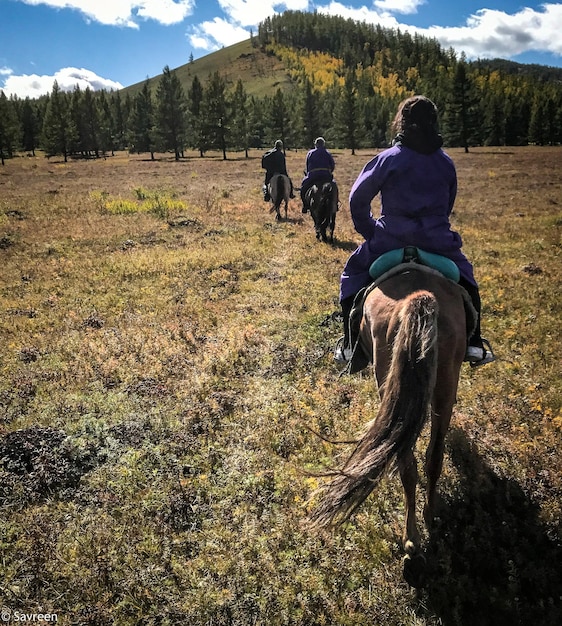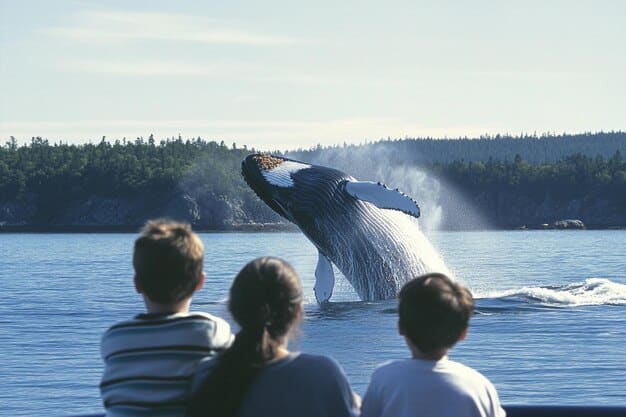Ethical Animal Tourism in the US: A Guide to Responsible Wildlife Encounters

Animal tourism in the US, when done ethically, offers enriching experiences that support conservation efforts and respect animal welfare, highlighting alternatives to exploitative practices and promoting responsible interactions with wildlife.
Animal Tourism in the US: How to Avoid Exploitation and Support Ethical Wildlife Encounters is a subject that requires careful consideration. The allure of seeing animals up close is undeniable, but it’s crucial to ensure these encounters are ethical and sustainable, protecting the animals and their habitats.
Understanding Ethical Animal Tourism
Ethical animal tourism focuses on minimizing harm to animals and maximizing benefits to conservation. It involves choosing activities that respect animals’ natural behaviors and habitats, avoiding places where animals are exploited for entertainment or profit.
What is Animal Exploitation?
Animal exploitation in tourism refers to the use of animals in ways that prioritize human entertainment or profit over their well-being. This can include activities like performing animal shows, riding elephants, or posing with drugged tigers.
- Unnatural Behaviors: Animals are trained to perform unnatural tricks for entertainment.
- Poor Living Conditions: Animals are kept in cramped, unsanitary environments.
- Physical and Psychological Harm: Animals suffer physical injuries and psychological distress due to training and captivity.
Identifying and avoiding these exploitative practices is the first step towards becoming a responsible animal tourist.

Identifying Ethical Animal Encounters
Not all animal tourism is harmful. Ethical encounters focus on conservation, education, and respect for the animals. By knowing what to look for, you can support responsible tourism models.
Sanctuaries vs. Zoos
Understanding the difference between sanctuaries and zoos is crucial. Sanctuaries prioritize animal welfare, offering a safe haven for rescued animals. Zoos, on the other hand, often focus on breeding and entertainment.
Ethical sanctuaries typically:
- Do not breed animals: They focus on providing a home for animals in need.
- Provide natural habitats: Animals live in environments that mimic their natural homes.
- Limit human interaction: Interaction is minimized to reduce stress on the animals.
By supporting ethical sanctuaries, you contribute to the well-being of animals and promote responsible tourism.
Choosing Responsible Tour Operators
The tour operator you choose can make a significant difference in the ethical impact of your animal tourism experience. Researching and selecting operators committed to responsible practices is essential.
Certifications and Accreditations
Look for tour operators with certifications from reputable organizations that promote ethical tourism. These certifications ensure the operator adheres to certain standards of animal welfare and environmental sustainability.
Consider these factors when selecting a tour operator:
- Transparency: The operator is open about their practices and impact.
- Conservation Efforts: The operator actively supports conservation projects.
- Respectful Interaction: The operator ensures respectful interactions with animals.
Choosing a responsible tour operator ensures your money supports ethical practices.

Supporting Conservation Through Tourism
Animal tourism can play an important role in conservation efforts. When done right, it generates revenue for conservation projects and raises awareness about the importance of protecting wildlife.
Community Involvement
Ethical animal tourism often involves local communities, providing them with economic opportunities and incentives to protect wildlife. This fosters a sense of stewardship and ensures the long-term sustainability of conservation efforts.
Benefits of community involvement include:
- Economic Empowerment: Local communities benefit from tourism revenue.
- Conservation Education: Communities learn about the importance of protecting wildlife.
- Sustainable Practices: Communities adopt sustainable practices that benefit both people and animals.
Supporting community-based tourism initiatives contributes to the overall success of conservation efforts.
Avoiding Common Pitfalls
Even with good intentions, it’s easy to fall into common pitfalls in animal tourism. Being aware of these pitfalls can help you make more informed and ethical choices.
Riding Animals
Riding animals, like elephants or camels, can cause significant physical and psychological harm. These animals are often subjected to cruel training methods and kept in poor conditions.
Consider alternatives such as:
- Walking Safaris: Explore the natural environment on foot.
- Photography Tours: Capture stunning images of animals in their natural habitats.
- Supporting Local Guides: Hire local guides who are knowledgeable about the area and its wildlife.
Avoiding animal rides is a simple yet impactful way to promote ethical tourism.
Promoting Ethical Wildlife Photography
Photography is a popular activity in animal tourism, but it’s important to ensure your photography practices are ethical. Avoid causing disturbance or stress to animals in pursuit of the perfect shot.
Respecting Boundaries
Maintain a respectful distance from animals and avoid approaching them too closely. Use a telephoto lens to capture close-up shots without disturbing their natural behavior.
Ethical photography practices include:
- Avoiding Flash Photography: Flash can startle or disorient animals.
- Not Baiting Animals: Avoid using food or other lures to attract animals.
- Respecting Nesting Sites: Keep a safe distance from nesting sites to avoid disturbing breeding animals.
By following these guidelines, you can capture stunning images while minimizing your impact on wildlife.
The Future of Animal Tourism
The future of animal tourism lies in promoting ethical and sustainable practices that benefit both animals and people. By making informed choices and supporting responsible initiatives, you can contribute to a more compassionate and sustainable future for wildlife tourism.
Education and Awareness
Raising awareness about ethical animal tourism is crucial. Share your experiences with others and educate them about the importance of responsible travel. By spreading the word, you can help create a more informed and ethical tourism industry.
Remember these principles:
- Choose ethical encounters.
- Support responsible tour operators.
- Promote conservation efforts.
Together, we can create a future where animal tourism is a force for good.
| Key Point | Brief Description |
|---|---|
| 🐢 Ethical Encounters | Focus on sanctuaries that prioritize animal welfare and natural habitats. |
| ✅ Tour Operators | Choose operators with certifications, transparency, and commitment to conservation. |
| 🚫 Avoid Exploitation | Say no to animal rides and performances that cause harm and stress. |
| 📸 Ethical Photography | Respect animal boundaries, avoid flash, and do not bait animals for photos. |
Frequently Asked Questions
▼
Animal tourism involves traveling to observe or interact with animals. Ethical animal tourism prioritizes animal welfare and conservation, distinguishing it from exploitative practices that harm animals for entertainment or profit.
▼
Ethical sanctuaries typically don’t breed animals, provide natural habitats, limit human interaction to reduce stress, and focus on rescued animals. They prioritize animal welfare over entertainment or profit.
▼
Riding animals can cause physical and psychological harm due to cruel training methods and poor living conditions. Choosing alternatives like walking safaris or photography tours is more ethical.
▼
Signs include animals performing unnatural behaviors, being kept in cramped or unsanitary environments, and suffering physical or psychological harm due to training and captivity.
▼
Maintain a respectful distance from animals, avoid flash photography, do not bait animals, and respect nesting sites. Use a telephoto lens to capture close-up shots without causing disturbance.
Conclusion
Embracing ethical animal tourism in the US requires conscious choices that prioritize animal welfare and conservation. By supporting responsible tour operators, avoiding exploitative practices, and promoting education and awareness, we can ensure that wildlife encounters are both enriching and sustainable for generations to come.





